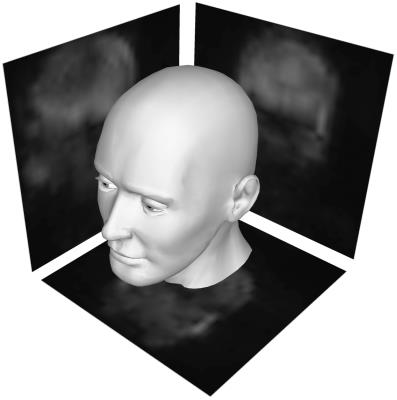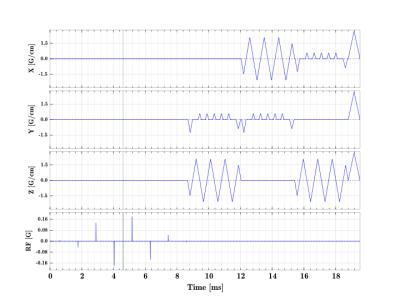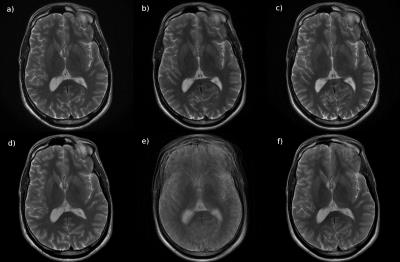0298
Towards a prospective motion correction for the clinic: increasing the accuracy and robustness of collapsed FatNav1Neuroradiology, Karolinska University Hospital, Stockholm, Sweden, 2Karolinska Institutet, Stockholm, Sweden
Synopsis
Collapsed FatNav is a navigator for prospective motion correction which samples the signal from the fat around the skull collapsed along three orthogonal directions with consecutive EPI readouts. The six rigid body motion parameters can be obtained by performing a 2D/3D projection-based registration. In this work we have greatly improved collapsed FatNav's accuracy and precision. Additionally, by combining with PROPELLER's retrospective correction, we can obtain image quality typical of images acquired without motion.
Introduction
Prospective motion correction techniques that utilize the MR scanner itself to estimate the patient's head position have compelling advantages, among others, operational simplicity and backward compatibility with existing hardware. On the other hand the navigators contend the scanner with the main sequence and this ultimately limits the temporal and/or spatial resolutions of the navigators' data. The consequence is a trade off between accuracy of the resulting motion estimates, scan time overhead and ability to track fast motion.
In a previous work1,2 we introduced the collapsed FatNav, which samples the signal from the fat around the skull collapsed along three orthogonal directions with consecutive EPI readouts. The six rigid body motion parameters can then be obtained by performing a 2D/3D projection-based registration. This technique allows for a very short navigator, especially when the main sequence already contains fat saturation pulses. On the other hand, the low resolution of the navigator's images and the distortion introduced by the EPI readouts limits the accuracy of the estimated motion parameters.
In this work, we approached the problem of improving the image quality in the presence of motion from two different angles. The first objective was to improve the accuracy and precision in the motion estimates. To this end, we redesigned the navigator sequence to increase resolution with respect to our previous work1, while at the same time increasing the acceleration to decrease the distortion. The 2D/3D registration algorithm was also updated to accommodate a backtracking step to reduce the estimates' variance.
On the other side, it is also important to reduce the effect of any remaining bias in the motion estimates. Hence, we propose to combine collapse FatNav with a PROPELLER main sequence. We expect the prospective correction to be able to compensate for most of the through-plane motion. This can enable PROPELLER's retrospective motion correction to improve further the image quality by correcting for small biases between different blades.
Methods
A collapsed FatNav navigator was embedded in a custom PROPELLER sequence. The navigator was configured with a FOV of $$$300mm$$$, a matrix size of $$$48\times48$$$ and an acceleration factor $$$R=8$$$. With these parameters, the resolution was $$$50\%$$$ higher and the pseudo-receiver bandwidth almost double with respect to our previous study1. Additionally, a binomial pulse with $$$8$$$ sub-pulses was used as excitation.
The PROPELLER data was acquired in single shot mode with a sampling window of $$$448$$$ points along the frequency direction, $$$\text{rBW}=50\text{kHz}$$$, refocusing flip angle $$$\alpha = 160^\circ$$$ and $$$\text{ETL}=24$$$. Furthermore the number of blades was adjusted in order to have a similar scan time with and without prospective motion correction ($$$1:34$$$ vs $$$1:38$$$min), accounting also for the time spent acquiring FatNav's calibration data ($$$\sim8s$$$). Each dataset was reconstructed twice, with PROPELLER's retrospective motion correction on and off.
A total of four scans were performed on a 1.5T GE DV450 scanner using a standard 8-ch brain coil, with and without prospective motion correction, with and without voluntary motion. In the scans with motion the volunteer was instructed to change head position at a voice command every 10 seconds throughout the scan. The motion pattern was performed as to draw a circle with the nose. This resulted in yaw and pitch rotations of up to $$$10^\circ$$$.
Results and discussion
The resulting images are shown in Figure 3 and 4. From image a), one can note that the proposed prospective correction does not introduce significant artifacts. By comparing images b) and f), it can be seen that even collapsed FatNav alone is more effective than PROPELLER's retrospective correction at handling through-plane motion. Nevertheless, in figure b) blurring and artifacts are still present, most probably due to bias introduced by distortion in FatNav's images. Fortunately, with the combination of prospective and retrospective motion correction as in image c), we can obtain an image quality similar to image a) and d) which were acquired without voluntary motion. Conclusion
In this work we have greatly improved collapsed FatNav's accuracy and precision. We have shown that the proposed prospective method is more effective than PROPELLER's retrospective correction alone. Additionally, the combination of the prospective and retrospective methods has been shown capable of delivering an image quality which is similar to images acquired without motion.
In future work, we intend to introduce the capability to reacquire data in the presence of extreme motion, in a similar way as PROMO3. Finally, a deeper investigation of the effect of distortion on the motion estimates is needed. It may be advantageous to split the navigator in multiple shots in order to further reduce distortions.
Acknowledgements
No acknowledgement found.References
[1] Avventi, E., Engström, M., Norbeck, O.,
Mårtensson, M., and Skare, S. Projection-based 2D/3D registration of
collapsed FatNav data for prospective motion correction. ISMRM, 2015
[2] Engström, M., Mårtensson, M., Avventi, E., Norbeck, O., and Skare, S. Collapsed fat navigators for brain 3D rigid body motion. Magnetic resonance imaging, 2015.
[3] White, N., et al. PROMO: Real-time prospective
motion correction in MRI using image-based tracking. Magnetic Resonance in Medicine, 2010
Figures



